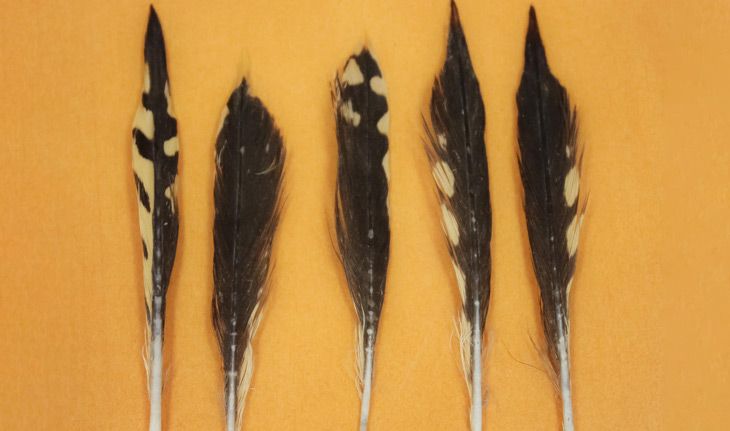Baby Sharks Do (Do, Do, Do, Do, Do) Eat Songbirds
A survey of 105 tiger sharks’ stomach contents revealed the remains of 11 land-based bird species
/https://tf-cmsv2-smithsonianmag-media.s3.amazonaws.com/filer/d6/d8/d6d8dd50-b121-4d47-b623-c01b7f76b2f6/figure_1a.jpg)
Tiger sharks aren’t exactly picky eaters. To date, scientists have found such oddities as license plates, tires, fishing gear, a chicken coop and unexploded munitions—not to mention more commonplace prey, including sea turtles, fish, whale carcasses and sea snakes—in the stomachs of these carnivorous apex predators.
But a new study published in the journal Ecology details perhaps the most surprising menu option yet: As researchers led by Marcus Drymon of Mississippi State University’s Coastal Research and Extension Center report, an eight-year analysis of 105 tiger sharks’ stomach contents has yielded evidence of 11 land-based bird species’ partially digested remains. In total, 41 of the 105 sharks, or 39 percent, dined on house wrens, barn swallows, eastern meadowlarks and similarly unexpected species prior to their capture and release back into the Gulf of Mexico. Roughly half of these bird-eating sharks were juveniles, suggesting that land birds are easier prey than seabirds and other marine creatures targeted by adult tiger sharks.
Crucially, Drymon explains in a press release, none of the birds identified “were seagulls, pelicans, cormorants, or any kind of marine bird." Rather, "they were all terrestrial," making it seemingly more plausible to spot them in a suburban backyard than in the belly of a shark.
According to National Geographic’s Jake Buehler, the most likely explanation for this unusual phenomenon is seasonal songbird migration, which finds hapless victims caught in autumnal storms and swept from the sky into the sea. As study co-author Kevin Feldheim of Chicago’s Field Museum says in the statement, “During migration, they’re already worn out, and then they get tired or fall into the ocean during a storm.” Once a land bird drops from the sky, “it’s probably done for,” in the words of bird ecologist Auriel Fournier, who tells the Atlantic’s Ed Yong that terrestrial avians lack the water-repelling oils found coating seabirds’ feathers.
During the land birds’ prime migration period between August and November, the juvenile tiger sharks are coincidentally three times more abundant off the coasts of Mississippi and Alabama. This easy scavenging opportunity, Yong writes, may even help explain why mother tiger sharks give birth in the open waters of the northern Gulf, rather than in more sheltered estuaries and mangroves.

“It’s almost like baby food,” Drymon tells to Yong. Even if the likelihood of a bird succumbing to a storm is low, the sheer scale of migration—an estimated two billion birds cross the Gulf every year—ensures a steady supply of tasty pickings.
The new findings stem from a chance encounter in 2010. As Sarah Zielinski writes for Science News, Drymon was tagging tiger sharks in the north-central Gulf when one vomited its stomach contents, complete with a number of barf-covered bird feathers, onto the deck of his boat. Hoping to pinpoint the species behind this feathery find, Drymon turned to Feldheim, who conducted DNA barcoding testing that identified the bird as a brown thresher. Intrigued, Drymon and his colleagues decided to conduct additional surveys of tiger sharks’ digestive systems. Jessica Boddy reports for Popular Science that the team studied the tums of dead sharks as well as living ones. To get a glimpse at the live sharks' lunch menu, they placed a tube down the creatures’ throats and sampled the sharks' stomach contents before returning them, unharmed, to the ocean.
To figure out why so many tiger sharks had managed to catch terrestrial songbirds, Fournier consulted eBird, a bird-watching database run by Cornell University. According to the Atlantic’s Yong, the data showed that peak sighting times for the 11 species identified—including eastern kingbirds, swamp sparrows, yellow-bellied sapsuckers and white-winged doves among others—almost directly correlated with the dates on which the researchers had collected feathers from the sharks’ stomachs.
Speaking with National Geographic’s Buehler, Samantha Munroe, a marine biologist at Australia’s University of Adelaide who was not involved in the study, says the research “helps change our perception about the connectivity between land and marine species” and provides a “jumping-off point for a myriad of other interesting” questions, including whether songbirds are more nutritious than other types of prey.
Feldheim raises a related point in an interview with Newsweek’s Kashmira Gander, asking, “If these bird populations suddenly crashed, would tiger sharks be affected, and if so, how much?”
He concludes, “Diet studies like this inform food web models which allow managers to consider the interactions between species and how changes in one may affect changes in another.”
/https://tf-cmsv2-smithsonianmag-media.s3.amazonaws.com/accounts/headshot/mellon.png)
/https://tf-cmsv2-smithsonianmag-media.s3.amazonaws.com/accounts/headshot/mellon.png)